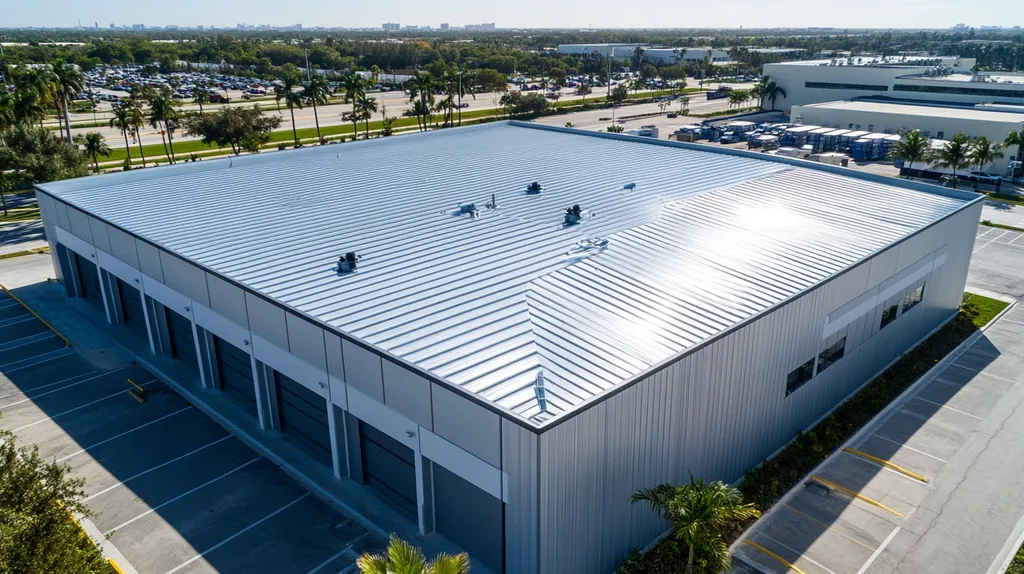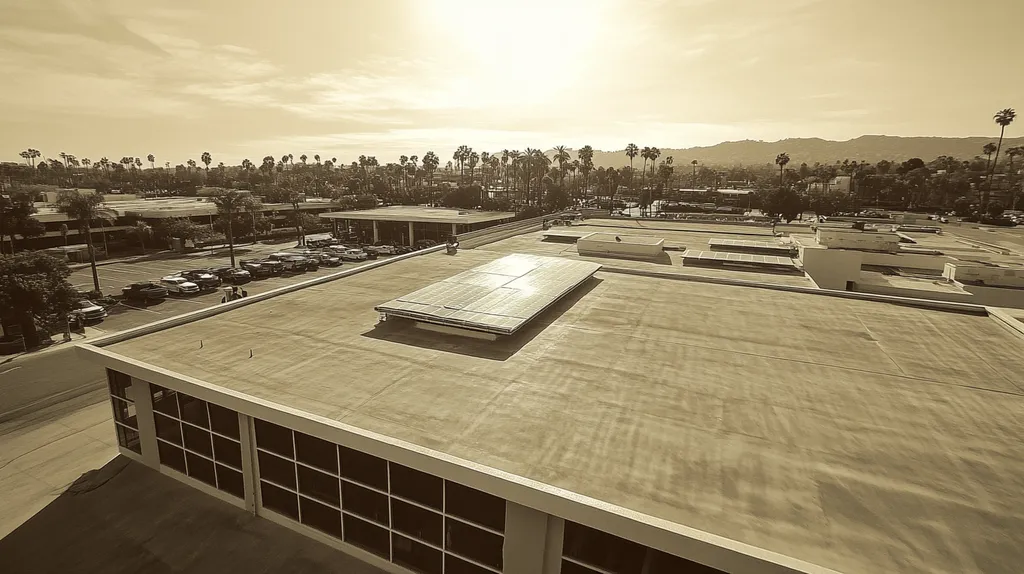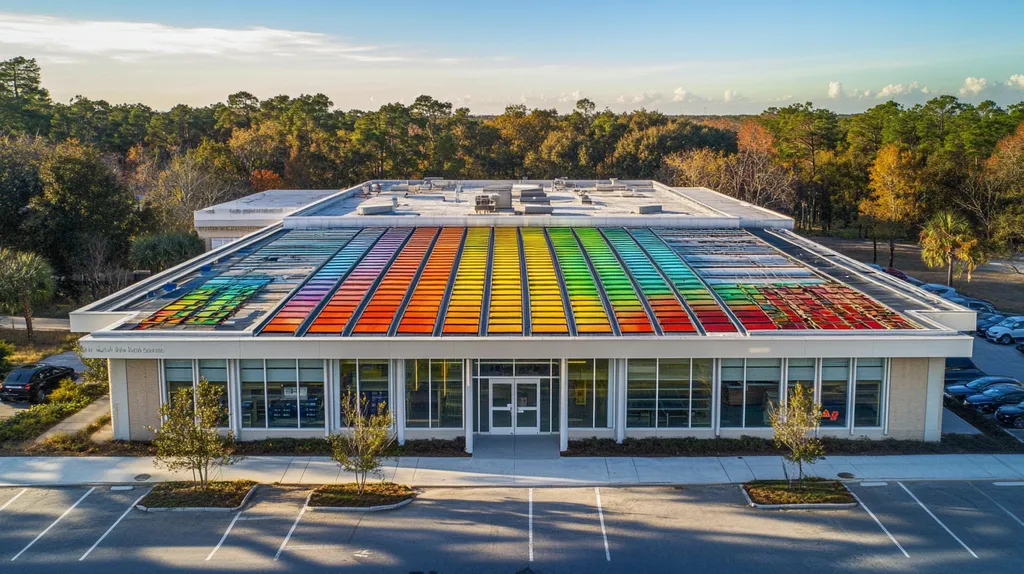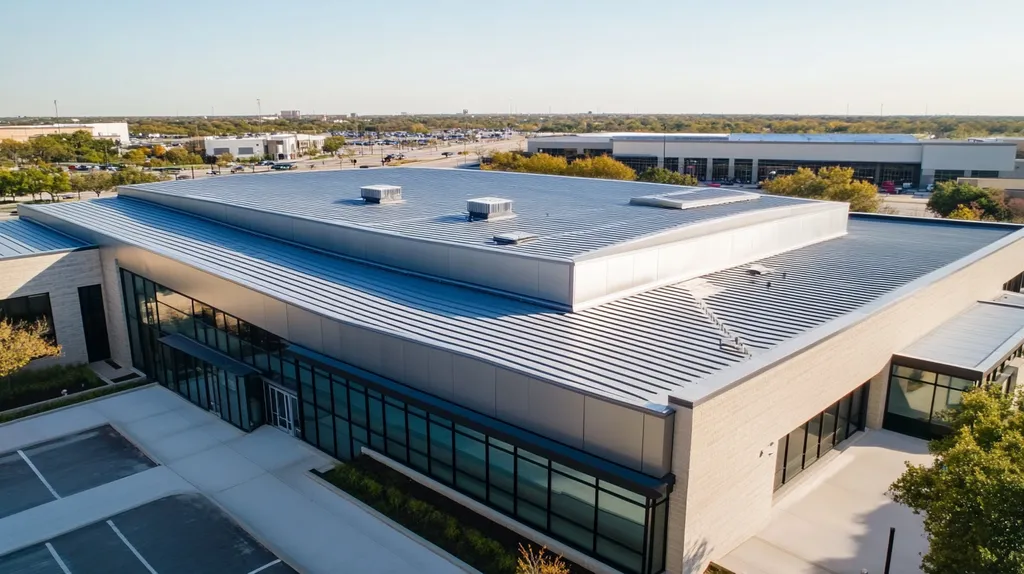Welcome to today’s Battle Royale featuring two roofing heavyweights: “Acrylic Coatings” in the east corner versus “Polyurethane Coatings” in the west!
Tonight’s showdown pits these contenders against each other across six punishing rounds designed to test every aspect of their performance for Commercial Roof Coating Applications.
At stake? Millions in potential costs, decades of building protection, and the critical performance demands of modern commercial and industrial facilities.
Our professional judging panel will evaluate each round on technical merit, real-world performance, and value delivery. After all six rounds, we’ll declare our ultimate champion.
Ladies and gentlemen, facility managers and building owners… it’s time to rumble!
ROUND 1: INITIAL COSTS & INSTALLATION
In commercial roofing, the stakes couldn’t be higher when selecting between acrylic and polyurethane coatings. A single misstep in material choice or application can result in premature failure, leading to extensive repairs and business disruption. Making an informed decision requires careful evaluation of initial investments, installation requirements, and project timelines.
Material Expenses
Initial material costs often drive coating selection decisions, with dramatic differences between options. Acrylic coatings typically cost 30-40% less per square foot than polyurethane alternatives, making them attractive for immediate budget considerations.
While acrylics offer lower upfront costs, they generally require reapplication every 5-7 years. This shorter lifecycle means property owners must budget for more frequent renewal cycles.
Polyurethane coatings command premium pricing but deliver 10-15 years of service life under normal conditions. Their superior durability and resistance to ponding water justify the higher initial investment.
When comparing total ownership costs over a decade, polyurethane coatings often prove more economical despite higher upfront expenses. ADVANTAGE: POLYURETHANE
Installation Complexity
The success of any coating system depends heavily on proper application techniques. Acrylic coatings offer straightforward installation with standard tools and methods, requiring minimal specialized training for crews.
The addition of thinners can contribute to premature failures or shortened service life. Thinning the coating may decrease the final film thickness, leading to improper weathering. (source: Roofing Contractor)
Polyurethane applications demand precise mixing ratios, temperature control, and specialized equipment. This complexity increases both labor costs and the potential for installation errors.
The simpler application process of acrylics reduces installation risks and contractor requirements. ADVANTAGE: ACRYLIC
Project Timeline
Project duration directly impacts facility operations and exposure to weather risks. Acrylic installations typically complete in 2-3 days, allowing rapid return to normal operations.
Weather sensitivity poses challenges for both coating types, but acrylics prove particularly vulnerable to moisture during curing. Application windows must be carefully planned around forecasts.
Polyurethane coatings require longer cure times and more stringent climate controls during installation. However, their superior performance typically results in fewer disruptions for reapplication.
The faster completion time of acrylic installations provides clear scheduling benefits. ADVANTAGE: ACRYLIC
ROUND 1 WINNER: POLYURETHANE COATINGS
ROUND 2: DURABILITY & LIFESPAN
When it comes to protecting commercial roofing assets worth millions, durability and lifespan become paramount considerations. Industry data shows that premature coating failures can multiply repair costs by 300% while reducing building energy efficiency by up to 40%. Understanding the performance characteristics of acrylic and polyurethane coatings over time is essential for making sound investment decisions.
Weather Resistance
Environmental exposure represents the primary threat to coating longevity. UV radiation, temperature cycling, and moisture penetration constantly test the limits of roof coating systems.
Acrylic coatings excel at UV resistance and maintain high reflectivity throughout their service life. However, they become brittle in cold temperatures and can suffer adhesion loss during freeze-thaw cycles.
Polyurethane coatings demonstrate superior resistance to temperature extremes and maintain flexibility across a wider range. Their chemical structure provides enhanced protection against UV degradation and weather exposure.
The proven durability of polyurethane in challenging climate conditions makes it the clear choice. ADVANTAGE: POLYURETHANE
Physical Durability
Commercial roofs must withstand regular foot traffic from maintenance personnel, equipment installations, and mechanical system servicing. Impact resistance and wear characteristics directly impact coating longevity.
Acrylic coatings provide adequate protection under light use conditions but can wear quickly in high-traffic areas. Their softer composition makes them more susceptible to mechanical damage and punctures.
Polyurethane coatings form a harder, more abrasion-resistant surface that better withstands physical impacts. Their superior tensile strength and tear resistance provide lasting protection even in heavy-use zones.
The robust physical properties of polyurethane deliver superior long-term performance. ADVANTAGE: POLYURETHANE
Service Life
Expected service life directly impacts return on investment and total ownership costs. Regular recoating cycles create both direct expenses and operational disruptions.
Acrylic coatings typically require reapplication every 5-7 years under optimal conditions. Environmental factors and usage patterns can further reduce their effective lifespan.
Polyurethane coatings consistently achieve 10-15 year service lives when properly installed. Their superior chemical and physical properties result in more predictable aging characteristics.
The extended service life of polyurethane coatings provides clear economic advantages. ADVANTAGE: POLYURETHANE
ROUND 2 WINNER: Polyurethane Coatings
ROUND 3: PERFORMANCE FACTORS
Performance factors represent the critical differentiators between success and failure in commercial roof coating applications. Studies show that improper coating selection leads to 40% of premature roof failures, resulting in millions in repair costs annually.
Understanding how different coatings perform under real-world conditions is essential for protecting valuable commercial assets. Modern coating technologies must deliver consistent performance across multiple environmental and operational challenges.
Durability
Durability under harsh conditions determines a coating’s ability to provide lasting protection. Commercial roofs face constant exposure to environmental stresses, mechanical loads, and chemical exposure.
Acrylic coatings offer good initial durability but can degrade more quickly when exposed to prolonged ponding water or chemical contamination. Their softer composition makes them more susceptible to physical damage from maintenance traffic.
Polyurethane coatings excel in chemical resistance and maintain their protective properties even under extreme conditions. Their superior tensile strength and impact resistance provide lasting protection against mechanical damage.
The proven durability advantages of polyurethane coatings make them the clear choice. ADVANTAGE: POLYURETHANE
Flexibility
Coating flexibility directly impacts long-term performance as buildings naturally shift and settle. Temperature fluctuations cause continuous expansion and contraction of roofing materials.
Acrylic coatings demonstrate excellent initial flexibility but can become brittle over time, especially in colder climates. This degradation of elasticity increases the risk of cracking and adhesion failure.
Polyurethane coatings maintain their flexibility throughout their service life, even under extreme temperature variations. Their molecular structure allows them to repeatedly stretch and recover without losing protective properties.
The superior long-term flexibility of polyurethane provides better protection. ADVANTAGE: POLYURETHANE
UV Resistance
UV radiation represents a primary threat to coating longevity and performance. Prolonged sun exposure can degrade chemical bonds and reduce protective properties.
Acrylic coatings provide outstanding natural UV resistance and maintain high reflectivity throughout their service life. Their chemical composition inherently resists UV degradation without requiring additional treatments.
Polyurethane coatings typically require additional UV-protective additives to achieve comparable performance. While effective, these additives can degrade over time, potentially reducing long-term UV resistance.
The natural UV-resistant properties of acrylic coatings give them a clear edge. ADVANTAGE: ACRYLIC
ROUND 3 WINNER: POLYURETHANE COATINGS
ROUND 4: MAINTENANCE REQUIREMENTS
Proper maintenance of commercial roof coatings directly impacts building protection and operational costs. Studies show that neglected roof coatings can fail in less than half their expected lifespan, leading to expensive repairs and potential business disruptions. Understanding the maintenance demands of different coating systems is crucial for long-term facility planning and budget allocation.
Cleaning Requirements
Regular cleaning prevents coating degradation and maintains reflective properties. Surface contaminants can accelerate wear and compromise coating adhesion if left unaddressed.
Acrylic coatings require minimal cleaning effort, typically needing only semi-annual washing to maintain performance. Their smooth surface naturally resists dirt accumulation and simplifies maintenance procedures.
Polyurethane coatings demand more frequent cleaning due to their tendency to attract and hold surface contamination. Their textured finish can trap debris, requiring additional effort to maintain optimal performance.
The simpler cleaning requirements of acrylic coatings provide clear maintenance advantages. ADVANTAGE: ACRYLIC
Inspection Frequency
Regular inspections ensure early detection of potential issues before they become major problems. Always follow manufacturer recommendations regarding preparation and avoid applying coatings on surfaces covered with frost and ice. (source: Earl W. Johnston Roofing, LLC)
Acrylic coatings typically require bi-annual professional inspections to assess coating integrity. Their predictable wear patterns make potential issues easier to identify during routine checks.
Polyurethane coatings need quarterly inspections to monitor for UV degradation and mechanical damage. Their complex chemical structure requires more frequent evaluation to ensure continued protection.
The reduced inspection requirements of acrylic coatings lower ongoing maintenance costs. ADVANTAGE: ACRYLIC
Repair Complexity
The ease of performing repairs impacts both maintenance costs and facility downtime. Quick, effective repairs prevent minor issues from escalating into major problems.
Acrylic coating repairs require minimal surface preparation and can typically be completed in a single day. Their simple chemistry allows for easy material matching and seamless integration with existing coatings.
Polyurethane coating repairs demand extensive surface preparation and precise application conditions. Their complex formulation makes patch repairs more challenging and time-consuming.
The straightforward repair process of acrylic coatings simplifies maintenance operations. ADVANTAGE: ACRYLIC
ROUND 4 WINNER: ACRYLIC COATINGS
ROUND 5: SUSTAINABILITY CREDENTIALS
Environmental impact has become a defining factor in commercial roofing decisions, with sustainability requirements now affecting everything from material selection to long-term facility costs. Studies show that roof coatings can reduce building energy consumption by up to 30% when properly specified. Understanding the environmental credentials of different coating systems helps property owners meet both performance and sustainability goals.
Environmental Impact
The environmental footprint of roof coatings extends from manufacturing through disposal. VOC emissions, material recyclability, and energy efficiency all factor into total environmental impact.
Acrylic coatings lead in environmental performance with low VOC content and water-based formulations. Their manufacturing process requires less energy and produces fewer harmful byproducts compared to other coating types.
Polyurethane coatings typically contain higher VOC levels and require more energy-intensive production methods. While some manufacturers offer low-VOC alternatives, these often come with performance trade-offs.
The superior environmental profile of acrylic coatings makes them the clear choice. ADVANTAGE: ACRYLIC
Energy Performance
Coating reflectivity directly impacts building energy consumption and urban heat island effects. High-performance coatings can reduce cooling costs by reflecting up to 85% of solar radiation.
Acrylic coatings maintain excellent reflectivity throughout their service life with minimal degradation. Their bright white finish helps maximize energy savings and reduce cooling loads.
Polyurethane coatings offer good initial reflectivity but may darken over time, reducing their energy-saving benefits. Their thicker application provides better insulation value but less solar reflection.
The consistent reflective properties of acrylic coatings deliver superior energy performance. ADVANTAGE: ACRYLIC
Lifecycle Assessment
Total environmental impact must consider the entire lifecycle from production through disposal. Factors include raw material sourcing, installation impacts, and end-of-life recyclability.
Acrylic coatings require more frequent reapplication, generating additional material waste and installation impacts. However, their water-based chemistry simplifies cleanup and disposal.
Polyurethane coatings last longer, reducing replacement frequency and associated environmental impacts. Their superior durability helps offset higher production energy requirements.
The extended service life of polyurethane provides better lifecycle sustainability. ADVANTAGE: POLYURETHANE
ROUND 5 WINNER: ACRYLIC COATINGS
ROUND 6: SPECIALIZED APPLICATIONS
Specialized commercial roofing applications present unique challenges that can make or break a coating’s performance. Industry data shows that 35% of premature coating failures occur in specialized use cases where standard application guidelines prove insufficient. Understanding how different coating types perform under demanding conditions is crucial for protecting valuable commercial assets.
Moisture Resistance
Standing water and persistent moisture exposure represent critical threats to coating performance in commercial applications. Low-slope roofs and complex drainage patterns create particular challenges for maintaining watertight integrity.
Acrylic coatings show initial resistance to moisture but can soften and deteriorate under prolonged water exposure. Their water-based chemistry makes them particularly vulnerable to ponding conditions, limiting their effectiveness in poor-drainage areas.
Polyurethane coatings maintain their structural integrity even under constant moisture exposure. Their superior chemical resistance and cross-linked structure prevent water infiltration while resisting degradation from ponding conditions.
The exceptional moisture resistance of polyurethane coatings provides clear performance benefits. ADVANTAGE: POLYURETHANE
Temperature Extremes
Commercial roofs face dramatic temperature fluctuations that test coating resilience. Surface temperatures can swing from below freezing to over 180°F in a single day, creating significant thermal stress.
Acrylic coatings become brittle in cold conditions and may crack under thermal cycling. Their temperature sensitivity restricts application windows and can compromise long-term performance in variable climates.
Polyurethane coatings maintain flexibility and adhesion across extreme temperature ranges. Their molecular structure allows for repeated expansion and contraction without compromising protective properties.
The superior thermal stability of polyurethane coatings delivers better protection. ADVANTAGE: POLYURETHANE
Chemical Exposure
Industrial environments expose roof coatings to harsh chemicals, emissions, and pollutants. These aggressive substances can rapidly degrade coating performance and compromise roof protection.
Acrylic coatings offer limited resistance to chemical exposure and may break down when contacted by industrial pollutants. Their simplified chemistry makes them vulnerable to a wide range of chemical compounds.
Polyurethane coatings demonstrate exceptional chemical resistance across a broad spectrum of substances. Their advanced polymer structure maintains integrity even under sustained exposure to industrial contaminants.
The robust chemical resistance of polyurethane coatings provides superior protection. ADVANTAGE: POLYURETHANE
ROUND 6 WINNER: POLYURETHANE COATINGS
AND THE WINNER IS…
After six grueling rounds of technical evaluation, we have our verdict. With four rounds to two, the undisputed champion of commercial roof coating applications is… POLYURETHANE COATINGS!
Polyurethane dominated the competition with knockout performances in durability, lifespan, and specialized applications. Its superior chemical resistance, flexibility under extreme conditions, and unmatched performance against moisture make it the heavyweight champion for demanding commercial environments.
But don’t count acrylic coatings out! This scrappy contender showed impressive strength in sustainability and maintenance rounds. For buildings in mild climates with regular maintenance schedules and strict environmental requirements, acrylic remains a worthy challenger.
IMPORTANT NOTICE: Every building faces unique challenges based on local climate, usage patterns, and structural characteristics. While this analysis covers major performance factors, it cannot account for all variables. Property owners should always consult qualified roofing professionals who can evaluate specific site conditions and requirements before making final coating selections.
Ladies and gentlemen, in the high-stakes world of commercial roofing, remember: The true champion isn’t just the coating with the most technical knockouts – it’s the one that best protects YOUR building for the long haul. Choose wisely, and may the best coating win!
FREQUENTLY ASKED QUESTIONS
Q. What are the initial costs for commercial roof coatings?
A. Initial costs vary significantly between coating options. Acrylic coatings are generally 30-40% less expensive than polyurethane coatings. However, while acrylics have lower upfront costs, they require reapplication every 5-7 years, potentially increasing long-term budget components.
Q. How do durability and lifespan compare for industrial roofs?
A. When assessing durability and lifespan, polyurethane coatings excel, lasting 10-15 years, while acrylic coatings generally require reapplication every 5-7 years. This lifespan difference can significantly affect maintenance budgets and service life expectancy for industrial roofs.
Q. What performance factors are critical for commercial roof coatings?
A. Key performance factors include durability under harsh conditions, flexibility to accommodate building movements, and UV resistance. It’s essential to select coatings based on these characteristics to minimize premature failures and repair costs for commercial roofs.
Q. How do maintenance requirements differ for commercial roof coatings?
A. Maintenance for acrylic coatings is generally simpler, requiring less frequent inspections and cleaning compared to polyurethane coatings. Acrylics often need bi-annual inspections, while polyurethane may necessitate quarterly evaluations to maintain efficiency and longevity.
Q. Which commercial roof coating is more environmentally sustainable?
A. Acrylic coatings are generally more environmentally friendly, as they often have low VOC content and are water-based. Their production typically requires less energy compared to polyurethane options, making them a more sustainable choice for commercial roofs.
Q. What considerations are there for specialized applications in industrial roofs?
A. Specialized applications often face unique challenges, like moisture resistance and chemical exposure. Polyurethane coatings outshine acrylics in these areas, as they maintain integrity under extreme conditions and resist degradation from industrial pollutants effectively.
Q. Can commercial roof coatings handle thermal fluctuations?
A. Polyurethane coatings are better equipped to handle thermal fluctuations than acrylic coatings. They maintain flexibility and adhesion across extreme temperature variations, whereas acrylics can become brittle in colder conditions, potentially leading to cracking and reduced performance.











